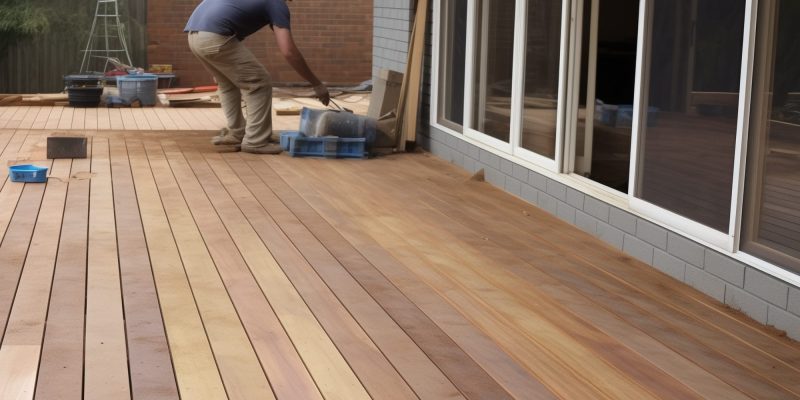Covering worn, damaged patio slabs with wooden decking creates an innovative new outdoor living space while avoiding costly full concrete removal. Read on to learn how building a deck over your patio can transform cracked, uneven concrete into an asset instead of an eyesore. We will cover the benefits of decking over slabs along with material options, cost comparisons, and tips for a successful installation.
Benefits of Decking Over Concrete Patios
Covering up aging, damaged concrete patios with new decking offers numerous advantages over a full slab demolition and rebuild. Read on to discover 5 compelling reasons to consider decking over your old slab rather than breaking out the jackhammers!
Avoids High Removal Costs
Decking over an existing slab allows you to avoid the high costs of full concrete removal, excavation work, hauling away debris, and pouring all new slab. In most cases, this project also costs significantly less than a full patio renovation performed by contractors. Combine those savings with the fact that you gain an entirely new wood deck surface, and decking over cracked concrete is extremely budget-friendly.
Gains Dimension/Height Above Ground Issues
By decking directly over a patio surface, you can raise the level of your living space, keeping it up out of mud or uneven lawn areas surrounding the concrete. The height difference also creates visual interest and extra privacy from ground-level sightlines.
Expands Entertaining Space Beyond Patio Size
Do you love hosting backyard gatherings but find your patio too narrow? Decking goes beyond the original footprint for more flexibility. Extend your entertaining capacity by cantilevering or adding free-standing decks adjacent to small, lackluster concrete slabs.
Flexibility in Layouts and Materials to Match Home
Concrete’s fixed shape and utilitarian appearance leave little room for design flair. Decking unlocks creativity! Complement architectural style through deck shapes, stamped concrete stains under gaps, railings, benches, and overhead structures.
Transforms Eyesores into Focal Points
Lifting cracked, uneven concrete slabs out of sight while installing beautiful new decking on top gives you the best of both worlds – an affordable cover-up along with a showpiece outdoor living area. Love your home from every angle again thanks to this innovative transformation technique we specialize in.
Evaluating if Your Patio is Ready for Decking
Before constructing a stunning new deck over lackluster concrete, carefully examine the existing slab for red flags that could cause problems down the road. Address any ongoing movement or clearance issues ahead of time and create an accurate site plan to ensure your project finishes strong.
Signs of Settlement Cracks or Ongoing Movement
Inspect the slab carefully for any cracks wider than 1⁄4 inch. Thin cracks that have remained unchanged for over 1 year are OK. However, deep gaps that continue growing wider indicate ongoing settling that must be addressed before decking over the concrete. Also check for corners visibly higher than others – a sign of frost heaving.
Frost Line Depth Requirements for Stable Footings
Footings supporting deck posts must extend below frost line depth to prevent shift from seasonal ground movement. Frost line depth varies by region but is typically 12-24 inches below grade. Building codes contain official frost line depths for proper footing sizes in your area.
Taking Accurate Patio Size Measurements
Create a detailed site map with exact patio dimensions, surrounding grades, door thresholds, and obstacles like AC units. This allows proper planning for traffic flow, stairs, and railings when laying out decking. Note any significant patio cracking locations, divisions between original pour and additions, or important underlying utility lines.
Considering Home Access Points and Door Thresholds
Will decking height obstruct home entries or violate ramp slope codes? Outdoor stair math ensures you achieve proper deck floor heights that align with indoor floors for smooth transitions. Planning ahead saves costly framing adjustments down the road.
Comprehensive Guide to Framing and Decking Over Concrete

Now that the structural inspection and site planning is complete, we can move on to the fun part – selecting beautiful decking materials for top-tier entertaining! Before that though, properly setting up the framing and moisture barriers is crucial to support stunning finishes long into the future.
Decking vs Patio Materials (Composites, Wood Types)
When selecting deck boards, consider weather resistance, durability, budget, and aesthetics. Composite decking lasts longer with no warping but costs more initially. Pressure-treated woods are affordable yet require periodic sealing, staining, splinter more easily, and may twist over time. Exotic hardwoods offer unparalleled beauty for a premium price.
Flashing Tape, Silicone Caulk for Water Protection
Prevent rotting framing by creating moisture barriers. Self-adhering flashing tape over the crack between walls and slabs, then quality outdoor silicone caulk seals openings water could infiltrate.
NOTE
Some foam weatherstripping tapes can further block ground vapors.
Framing with Pressure-Treated Joists and Spacers
Elevate framing above patio grade using 1×2” spacers on 12” centers screwed to slab. This allows ventilation, drainage and airflow to prevent premature wood rotting. Screw properly spaced 2×6 pressure-treated joists into spacers using 3” Tapcon concrete screws. Overbuild supports at decking seam locations.
Shimming Techniques for Level Finish Surface
Use shims between spacers and joists to compensate for slab imperfections. Check level and plane during construction, adjusting shims gradually rather than forcing joists to plane. Prevent bounciness with closely spaced shims blocking joists from above on uneven slabs.
Finalizing Deck Layouts and Traffic Flow
Minimize blocking views with railings, private nooks, and benches arranged off center. Stagger deck board seams pleasingly; picture framing the perimeter unifies disjointed shapes. Steering foot traffic sideways to concrete minimizes dirt tracked onto decking. Don’t impede drainage flow.
Personalizing Your New Deck with Custom Touches
After all the structural framing work is complete, this is where the fun really begins! Now is your chance to add thoughtful accents that complement your home’s architecture, reflect your unique style, and take your entertaining game to the next level.
Staining/Painting Enclosed Concrete Before Deck Framing
Staining or painting the concrete slab edges visible between deck board gaps unifies the aesthetic before enclosing it entirely from view. Select concrete paints/stains in the same tone family as your deck stain for cohesion.
Incorporating Planter Boxes, Benches, Lighting
Further personalize your new space by building in planter boxes along borders or rails to green it up. Integrate corner benches and lighting fixtures seamlessly during framing for flush embeddings. Thematic elements like nautical rope railings or wine barrel planters inject personality.
Adding Weatherproof Cabinets
Take your entertaining capabilities even further by waterproofing framing borders for built in outdoor cabinetry. Protect grills, sinks, mini fridges, kegerators and bartending supplies from the elements while keeping frequently used items handy.
Privacy Screens and Overhead Structures (Pergolas)
Install lateral privacy screens or an overhead pergola lined with hanging lights or plants for an intimate vibe. Support vine growth by integrating vertical structures as unobtrusive corner posts or rail accents during framing.
Safety Considerations for Access and Railings
Safety should always remain the top priority when building outdoor living spaces, especially when elevated above ground level. Ensure your new deck project meets all codes through smart material choices and visibility-enhancing transparent panels where applicable.
Building Code Handrail Height Requirements
Deck railings must stand 36-42 inches tall per IRC building codes to prevent accidental falls. The same goes for stairs with 3 or more risers – install graspable handrails 34-38 inches high above tread edges. Outdoor deck code compliance is crucial for safe family use.
Options for Access (Stairs, Ramps, Gates)
Match architecture styles when choosing stair materials – wrought iron, stone, poured concrete, cable rail glass infill panels or simple wood pickets offer striking choices. Consider gentler slope ratios if aging guests visit often. Self-closing outdoor gates enhance child safety near pools or retaining walls behind decks.
Glass Panel Railings to Preserve Views
Low-profile glass infill panel railings or cable rails with thin balusters provide unimpeded views beyond deck borders with full code compliance. Glass clamps anchor securely between top and bottom barriers. Maintenance is key with glass; inspect fittings routinely for re-tightening.
Project Costs and Factors to Keep in Mind
Decking over concrete delivers stunning transformations cost-effectively compared to full patio rebuilds. Here is what to expect expense-wise for materials, labor, and upkeep over your new outdoor oasis’ lifetime.
Material Expenses Can Vary ($15 – $35 per Square Foot)
Decking over concrete costs roughly $15-35 per square foot depending on materials selected. Composites fall at the upper end while pressure-treated wood is most affordable. Factor $500-1000 for associated framing components on a 12×12’ patio.
Labor Time Investments if Undertaking DIY
While experienced DIYers tackle this type of project every day, also weigh how much your personal time is worth if learning on the fly. Some find paying a professional contractor worth the investment after pricing total material runs and anticipating the learning curve.
Long-Term Maintenance of Wood Decking
All exposed wood decking requires periodic sealing/staining even when utilizing hardy pressure-treated boards. Yearly upkeep is recommended to protect investments from weathering. Composite alternatives feature color and texture throughout their profile, eliminating frequent treatments.
Let Us Bring Your Concrete Decking Vision to Life
Ready to turn your concrete liability into a wood deck entertainment oasis? Contact us today for a complimentary design consultation and quote custom-tailored exactly to your project scope, lifestyle needs, and budget.

